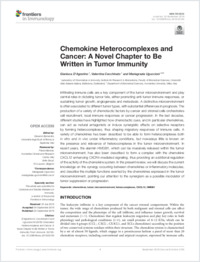Chemokine heterocomplexes and cancer : a novel chapter to be written in tumor immunity
- D'Agostino, Gianluca Institute for Research in Biomedicine (IRB), Faculty of Biomedical Sciences, Università della Svizzera italiana, Switzerland
- Cecchinato, Valentina Institute for Research in Biomedicine (IRB), Faculty of Biomedical Sciences, Università della Svizzera italiana, Switzerland
- Uguccioni, Mariagrazia Institute for Research in Biomedicine (IRB), Faculty of Biomedical Sciences, Università della Svizzera italiana, Switzerland - Department of Biomedical Sciences, Humanitas University, Milan, Italy
-
25.09.2018
Published in:
- Frontiers in immunology. - 2018, vol. 9, p. 2185
English
Infiltrating immune cells are a key component of the tumor microenvironment and play central roles in dictating tumor fate, either promoting anti-tumor immune responses, or sustaining tumor growth, angiogenesis and metastasis. A distinctive microenvironment is often associated to different tumor types, with substantial differences in prognosis. The production of a variety of chemotactic factors by cancer and stromal cells orchestrates cell recruitment, local immune responses or cancer progression. In the last decades, different studies have highlighted how chemotactic cues, and in particular chemokines, can act as natural antagonists or induce synergistic effects on selective receptors by forming heterocomplexes, thus shaping migratory responses of immune cells. A variety of chemokines has been described to be able to form heterocomplexes both in vitro and in vivo under inflammatory conditions, but nowadays little is known on the presence and relevance of heterocomplexes in the tumor microenvironment. In recent years, the alarmin HMGB1, which can be massively released within the tumor microenvironment, has also been described to form a complex with the chemokine CXCL12 enhancing CXCR4-mediated signaling, thus providing an additional regulation of the activity of the chemokine system. In the present review, we will discuss the current knowledge on the synergy occurring between chemokines or inflammatory molecules, and describe the multiple functions exerted by the chemokines expressed in the tumor microenvironment, pointing our attention to the synergism as a possible modulator of tumor suppression or progression.
- Language
-
- English
- Classification
- Medicine
- License
- Open access status
- gold
- Identifiers
-
- RERO DOC 326631
- DOI 10.3389/fimmu.2018.02185
- ARK ark:/12658/srd1318964
- Persistent URL
- https://n2t.net/ark:/12658/srd1318964
Statistics
Document views: 160
File downloads:
- Texte intégral: 180
